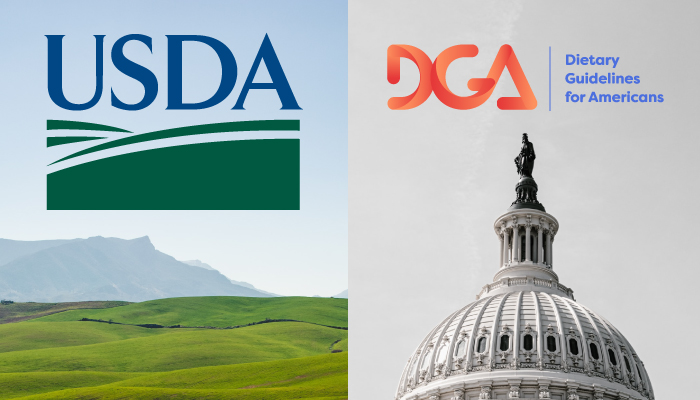USDA Announces 2020-2025 Dietary Guidelines for Americans

The United States Department of Agriculture (USDA) and Health and Human Services (HHS) today released its 2020-2025 Dietary Guidelines for Americans (DGAs). This edition of the guidelines marks the first time the USDA organized its recommendations by life stage, outlining dietary needs from birth to older adulthood, and is the first time since 1985 the USDA has included dietary guidance for infants and toddlers.
The guidelines include “nearly all” of the science-based recommendations of the 2020 Dietary Guidelines Advisory Committee, according to the USDA, but they do not include the committee’s recommendation to adjust allowances for added sugar and alcohol intake.
Released every five years and developed through recommendations from a panel of 20 health and nutrition experts, the DGA is the basis for federal food, nutrition and health policies as well as public education materials. This year, the guidelines were rolled out alongside a new “Make Every Bite Count” marketing campaign, containing key recommendations for “healthy dietary patterns” that are largely consistent with previous iterations. These include consuming nutrient-dense foods and beverages with core elements including vegetables, fruits, grains, dairy and protein from meat, poultry, eggs, seafood, nuts and seeds, while limiting intake of added sugars, saturated fats, sodium and alcoholic beverages.
The process of releasing the guidelines wasn’t without controversy, as several organizations including the Academy of Nutrition and Dietetics and The Nutrition Coalition in June called for a delay in publication of the expert report authored by the Dietary Guidelines Advisory Committee which would inform the official DGAs. Citing delays due to the COVID-19 pandemic and government shutdowns, the groups urged the USDA to push publication October to allow experts more time to review studies and research to inform their report, though the USDA ultimately maintained its planned July publication date.
Added Sugar and Alcohol Consumption Guidance
While the 2020-2025 DGAs emphasize the importance of limiting added sugar and alcoholic beverage intake, the USDA decided not to move ahead with a couple of highly scrutinized suggested changes to quantitative limits, a change that was recommended by the Dietary Guidelines Advisory Committee. In a report released in July, the committee recommended that the USDA cut the limit of added sugar intake from 10% to 6% of daily calorie consumption for those over two years old to reduce risk of obesity-related health problems. It also suggested the reduction of the allowance of two drinks per day for men and one for women to one per day for both men and women to decrease mortality risk.
In both cases, the USDA stated there was not a “preponderance of evidence” in studies conducted since the last iteration of the guidelines was released to support making changes to these quantitative recommendations. The decision to reject these suggestions from the committee were supported by public comments from beverage and alcohol industry groups this summer after the committee released its report in July.
In a public comment submitted in August, the American Beverage Association (ABA) supported maintaining the 10% of daily calorie limit to “provide real-world guidance of balance, moderation and ‘choice’” that is “meaningful, practical and achievable for most Americans.” In reference to today’s guidelines, ABA stated on Twitter that “America’s leading beverage companies look forward to continuing our work with government & public health groups to support families in their efforts to balance their diets & moderate sugar.”
The Beer Institute and Brewers Association also filed a public comment in August pushing back against the proposed change to daily alcohol limits, with Beer Institute president and CEO Jim McGreevy stating in a press release that changing the recommendation of men’s daily alcohol consumption “without a sound scientific basis will only create confusion for policymakers, healthcare professionals, and consumers.”
The American Institute for Cancer Research, which also submitted comment letters this summer, said in a press release today that it is “disappointed that the USDA and HHS has bowed to industry pressure” and rejected the committee’s suggestions for added sugar and alcohol intake. The Physicians Committee for Responsible Committee also voiced concerns about the USDA’s support of meat and dairy consumption, claiming that these calcium sources are shown to increase risk of prostate and breast cancer, particularly in Black Americans. The group recommended the USDA support non-dairy calcium sources and increase emphasis on plant-based foods.
Suggestions for Infants, Toddlers and Pregnant and Breastfeeding Women
For the first time in decades, the DGAs also laid out recommendations for infants and toddlers as well as women who are pregnant or breastfeeding.
The USDA recommendations infants be fed human milk exclusively for the first six months of life and iron-fortified formula if this is not possible. Infants should also receive supplemental vitamin D soon after birth, and receive “age and developmentally appropriate” foods at six months.
Along with other complementary foods, the USDA recommended infants be introduced to potentially allergenic foods such as peanuts, eggs, cow milk products, tree nuts, wheat and shellfish. Introducing foods containing peanuts to infants within the first year of life reduces their risk of developing a peanut allergy, the USDA noted, and infants at high risk of developing a peanut allergy should begin consuming peanut-containing foods as early as four months old.
The move to recommend early allergen-exposure via food comes soon after the FDA sent warning letters to several infant food brands that introduce children to potential food allergens. The letters claimed, among other issues, that there was not, at the time, sufficient evidence to prove introducing children to any allergen other than peanuts could result in a decrease in food allergies.
According to the guidelines, infants should also be introduced to foods rich in zinc and iron around six months, and during the second year of life, vitamin D, calcium, dietary fiber and potassium. The USDA suggests infants and toddlers avoid foods and beverages with added sugars or honey as well as unpasteurized foods and beverages, and limit consumption of those that are higher in sodium.
The USDA also included recommendations for women who are pregnant or lactating, which is largely consistent with the health dietary patterns of adults. The guidelines note the importance of folate and folic acid, iron, iodine and choline-containing foods, such as eggs, meats, some seafood, beans, peas and lentils, during this period.
Emily Metz, president and CEO of the American Egg Board, said the USDA’s recommendations of egg consumption for both infants and pregnant and lactating mothers “confirm what the science has shown: eggs provide critical nutritional support for brain health, and they play a crucial role in infant development and prenatal health.”
Lisa Gable, CEO of FARE (Food Allergy Research and Education) said the group was “thrilled” to see the USDA’s recommendation regarding infants’ egg and peanut consumption.
“The early introduction of proteins that can trigger an allergic reaction is a leading priority for FARE and is woven throughout much of our work, including our Baby’s First initiative and the Start Eating Early Diet (SEED) study, which is grounded in the success of the 2015 FARE-funded Learning Early About Peanut Allergy (LEAP) study,” she said in a statement. “We look forward to continuing to work with both agencies as well as leaders in food allergy to advance comprehensive clinical research and education strategies in multi-allergen early introduction.”
















